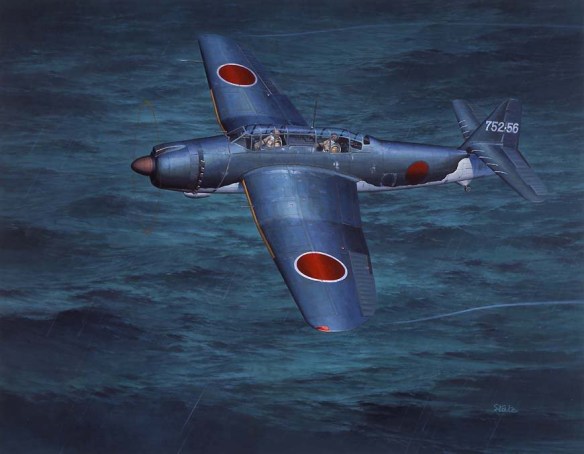B7A2 Unit: Kougeki (Attack) 5th Hikotai, 752nd Kokutai Serial: 752-03
Katori Naval Air Base, Chiba prefecture, end of April 1945.
B7A2 Unit: Kougeki (Attack) 5th Hikotai, 752nd Kokutai Serial: 752-53
Kisarazu Naval Air Base, Chiba prefecture, after May 1945.
Aichi’s B7A Ryusei torpedo bomber (‘Grace’) was part of the 16-Shi (1942) programme. It was intended to extend the reach of Japanese carriers and thus to minimise the problem of carrier air defence: if the Japanese fleet could outreach the US fleet, and if its aircraft could penetrate US defences, then it could strike without being struck. The Japanese consistently managed to outrange the US fleet, but the combination of effective fighter control and effective anti-aircraft fire made that outreach useless. The Ryusei was intended to replace both the standard attack aircraft: the B6N torpedo bomber and the D4Y dive bomber. Given enough engine power, an airframe stressed to dive-bomb could lift a torpedo. That was the case with both the US SB2C Helldiver (although it was not used as a torpedo bomber) and the British Barracuda (a torpedo bomber used exclusively as a dive bomber). Manoeuvrability was to be equal to that of a Zero (A6M) fighter, to give the Ryusei reasonable immunity from interception. Normal range was to be 1000nm (maximum 1800nm). The prototype was completed in May 1942. Note that the operational concept considerably predated Midway. Production seems to have been hampered by slow engine development, as it did not begin until April 1944.
In June 1944, IJN Taihō, the only Imperial Japanese Navy aircraft carrier then large enough to operate the B7A Ryusei in its intended role, was sunk during the Battle of the Philippine Sea before enough B7As were even available to embark. Thereafter, the B7A was relegated to operating from land bases, primarily with the Yokosuka and 752nd Air Groups. The Japanese completed only one other carrier capable of operating the B7A, IJN Shinano, but she was sunk by an American submarine.
Aichi B7A1/B7A2 differences
I believe there are some minor differences in the cowling and exhausts because of the difference in the two versions engines.
According to Francillon, just 9 B7A1s were built. I have a picture of one with tail marking “Ko-B7-7”, so this was presumably the 7th built, and it has a retractable tailwheel. I have not found any pictures purporting to be of B7A1s in service, and all in service seem to have had the fixed tailwheel.
The B7A1 was overweight and there were also structural problems in the wings. The wing internal structure was totally redesigned among other things, so there may be differences in panel arrangements.
According to Francillon, the only differences were a slightly improved engine version, and replacement of the rear 7.92mm gun with a 13.0mm.
The same two engine models were used interchangeably in the Ki-84 I (Ha[45]11 and Ha[45]12) with no alteration in outward appearance.
British CAP Interception
The four ‘dusk’ patrol Hellcats from the 1844 NAS detachment embarked in Formidable were airborne at the time, and they were quickly vectored onto a quartet of Aichi B7A ‘Grace’ torpedo-bombers flying at 20,000 ft on a heading for the ships. The Hellcats, flown by Sub Lts Atkinson, Foster, Mackie and Taylor, made short work of the rarely seen B7As, as is described in the official Royal Canadian Navy history;
‘During his attachment to Formidable, Atkinson achieved a rare distinction on the night of 25 July. Four Hellcats were scrambled on a night combat air patrol. These were conventional Hellcat IIs without radar, but their pilots had been trained in night flying. Shortly after assuming patrol, incoming Japan- ese aircraft were detected. Two Hellcats were forced to return to the carrier unserviceable. Sub Lt Atkinson assumed the lead of the remaining two Hellcats and was vectored out on an intercepting course.
‘Under a full moon, Atkinson identified the bandits as big, single-engined “Grace” torpedo-bombers, and took his New Zealand wingman, Sub Lt R F Mackie, into the attack. Atkinson latched onto a pair of “Graces” and shot them both into the water, while Mackie dumped the third. Then, in routing the other bandits, a fourth “Grace” went down and the enemy attack was completely broken up.
#
An intact and unused cockpit canopy discovered in Kumamoto Prefecture, Japan, has been confirmed as an Aichi B7A Ryusei (Shooting Star) torpedo/dive- bomber. It is generally believed to be the only known part of the aircraft type, which was also used in kamikaze attacks, to exist in Japan. A spokesman from the local industrial heritage study group, said: “The canopy has historical value as it shows Japan’s aeronautical industry heritage and conveys the tragic reality of war.”
The Ryusei, which served the Imperial Japanese Navy, is sometimes referred to as the ‘last suicide attack plane’ because naval records show that two Ryusei aircraft departed on kamikaze missions on August 15, 1945, the day Japan surrendered to the Allies. Ryusei production began in April 1944 and its cockpit canopies were manufactured in Yatsushiro, Kumamoto Prefecture. Around 110 Ryusei aircraft were completed. The relic is considered a precious historical record because most Japanese wartime equipment was destroyed. The only remaining Ryusei is at the Smithsonian National Air and Space Museum in Washington, DC.
